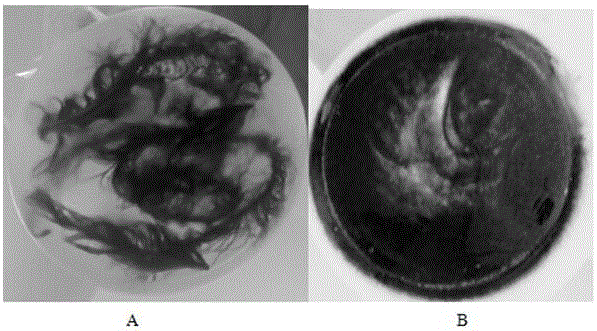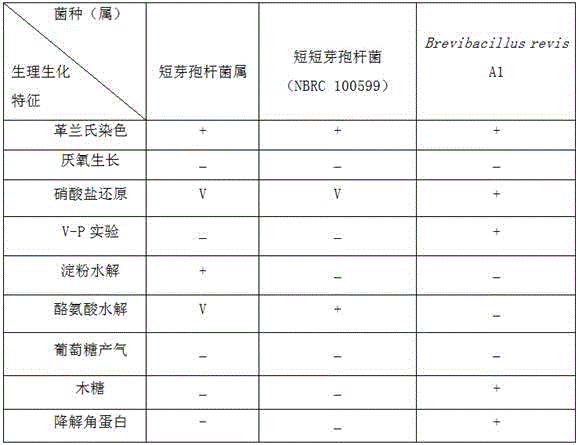Brevibacillus brevis strain and application thereof
A technology of Bacillus brevis and strains, applied in the field of microorganisms, can solve the problems of corrosion of equipment, low efficiency of alkaline method, low yield of compound amino acids, etc., and achieve remarkable results
- Summary
- Abstract
- Description
- Claims
- Application Information
AI Technical Summary
Problems solved by technology
Method used
Image
Examples
Embodiment 1
[0032] Example 1: Obtaining of Bacillus brevius strain Brevibacillus brevisA1
[0033] ①Collect feathers from the place where the feathers are piled up, take 5g of feathers and put them into a triangular flask filled with 100mL of sterile water, shake and mix, let stand for 10 minutes, absorb 1mL of supernatant and make gradient dilution to 10 -7 , take 100 μL of each gradient and smear it on the primary screening medium plate; incubate at 37°C for 72 hours, and pick the colonies grown on the plate;
[0034] The composition of the primary screening medium is: potassium dihydrogen phosphate 1.5g, magnesium sulfate heptahydrate 0.025g, calcium chloride 0.025g, ferrous sulfate heptahydrate 0.015g, feather meal 10g, agar 15g, distilled water 1000ml.
[0035] ② Inoculate the obtained single colonies into the re-screening medium respectively, shake culture at 37°C, observe the degradation of feathers after 48 hours, and measure the soluble protein content and the degradation rate of...
Embodiment 6
[0038] The total DNA of the strain was extracted, the target fragment was amplified with bacterial 16SrDNA universal primers, and the fragments were recovered, cloned and sequenced. The 16SrDNA similarity comparison of the bacterial 16SrDNA gene fragment sequence was performed using NCBI's BLAST, and the results showed that it was 99% homologous to Brevibacillus brevisNBRC100599. It was initially identified as Bacillus brevius and named A1.
Embodiment 2
[0039] Embodiment 2: Brevibacillus brevisA1 strain measures the weight loss rate of feather degradation
[0040] (1) Wash, dry and weigh the chicken feathers;
[0041] (2) Add 2g of chicken feathers into 100mL of re-screened medium and sterilize;
[0042](3) 1mL Brevibacillus brevisA1 bacteria solution (OD 600 0.4) inoculated into the re-screening medium, cultured with shaking at 37°C for 48 hours, observed the degradation of feathers, and the degradation effect was as follows: figure 1 shown;
[0043] (4) Filter the fermentation broth, collect the residue and dry it to a constant weight, and calculate the feather weight loss rate; the feather weight loss rate calculation formula is:;
[0044] (5) Calculations show that the feather weight loss rate is 61.5%.
PUM
 Login to View More
Login to View More Abstract
Description
Claims
Application Information
 Login to View More
Login to View More - R&D
- Intellectual Property
- Life Sciences
- Materials
- Tech Scout
- Unparalleled Data Quality
- Higher Quality Content
- 60% Fewer Hallucinations
Browse by: Latest US Patents, China's latest patents, Technical Efficacy Thesaurus, Application Domain, Technology Topic, Popular Technical Reports.
© 2025 PatSnap. All rights reserved.Legal|Privacy policy|Modern Slavery Act Transparency Statement|Sitemap|About US| Contact US: help@patsnap.com


